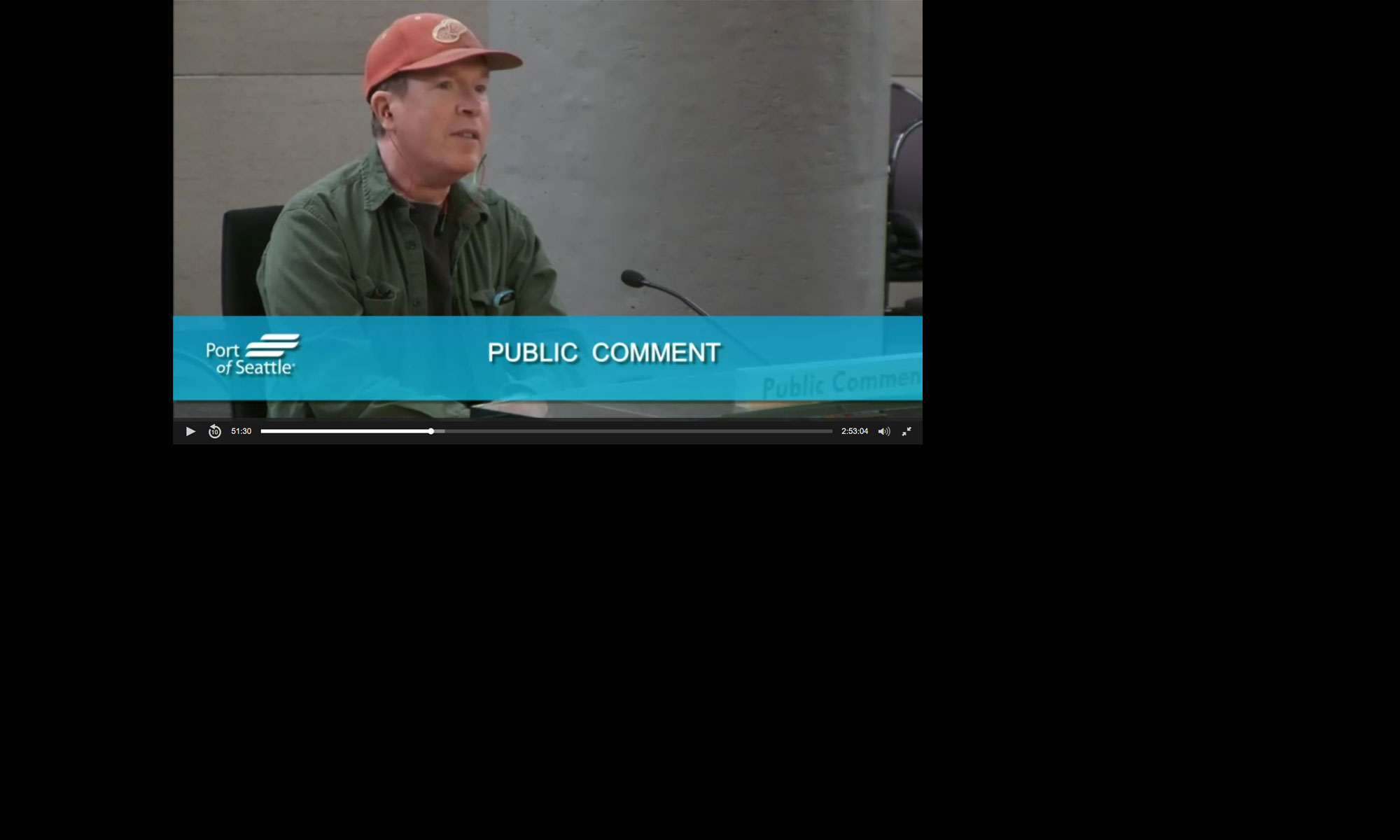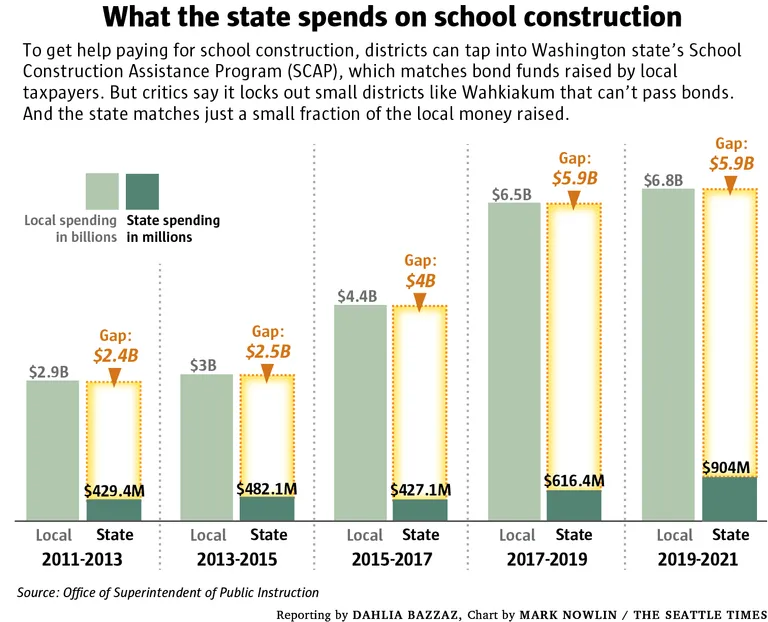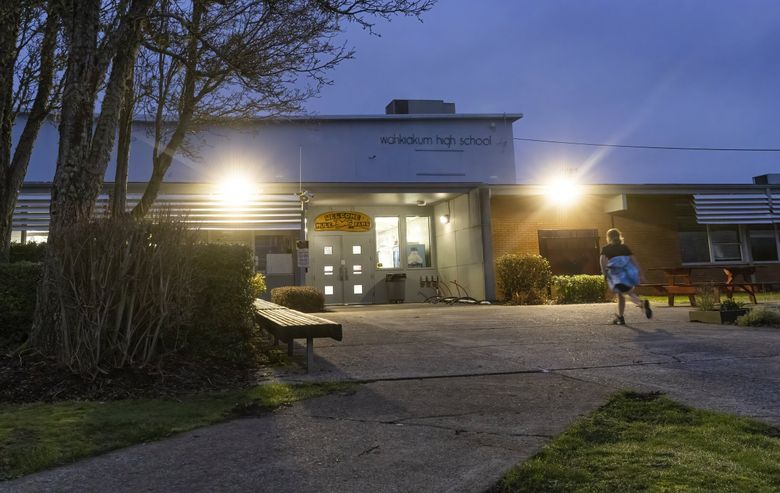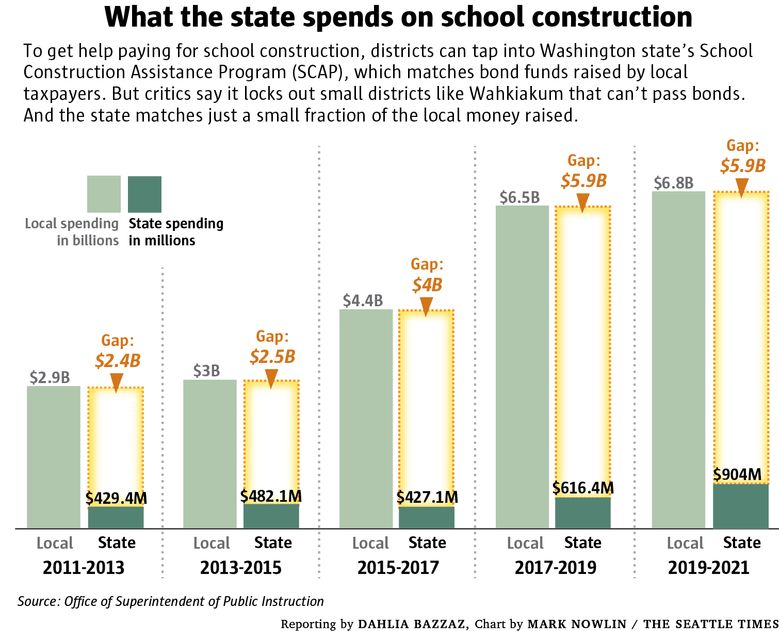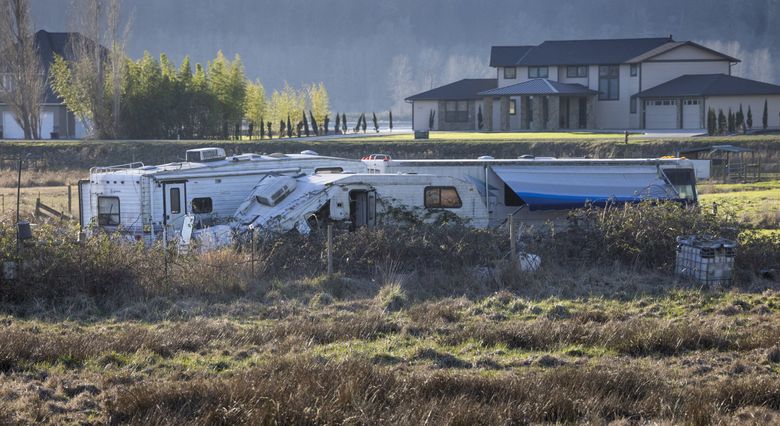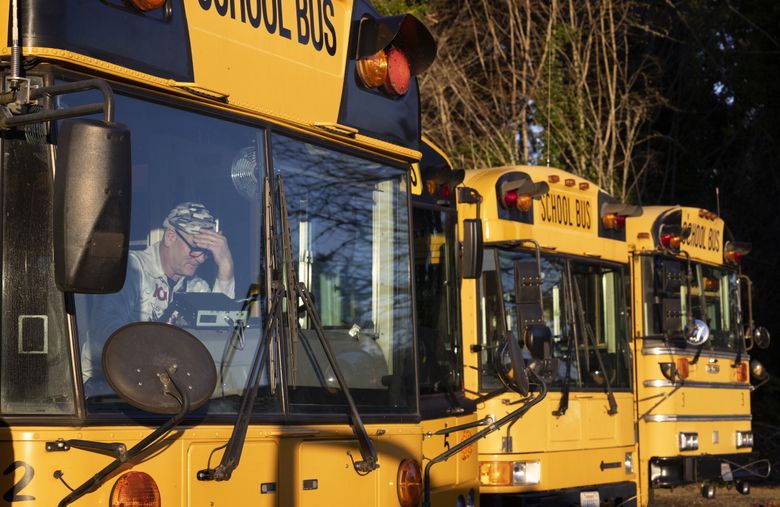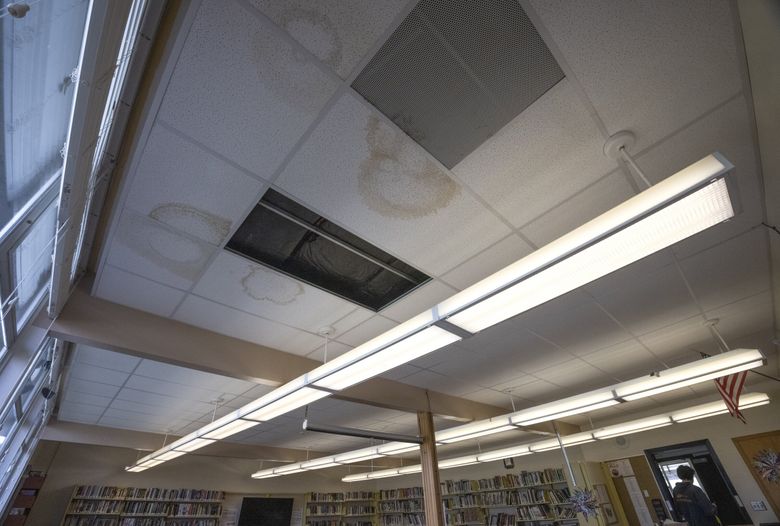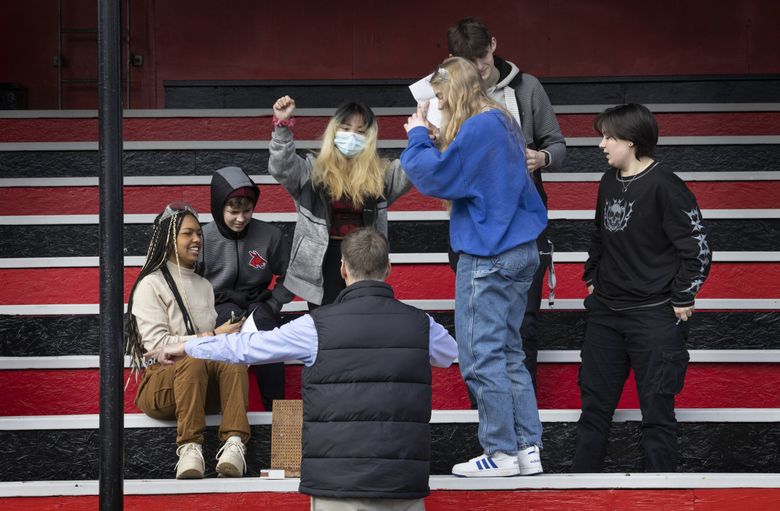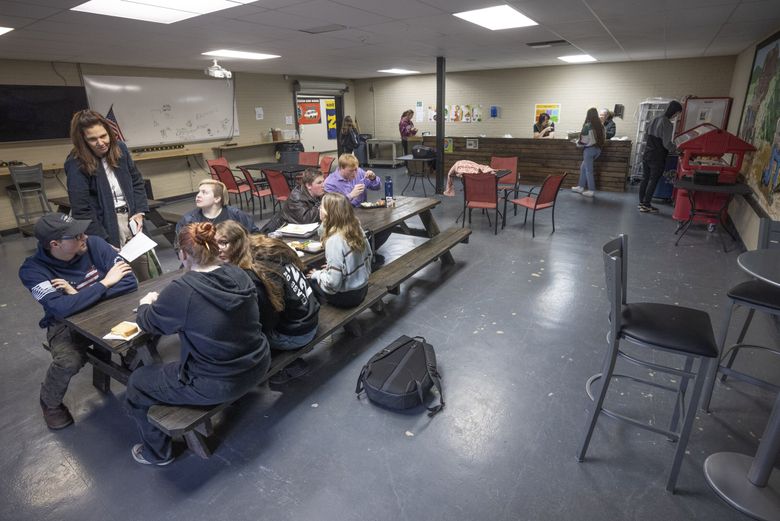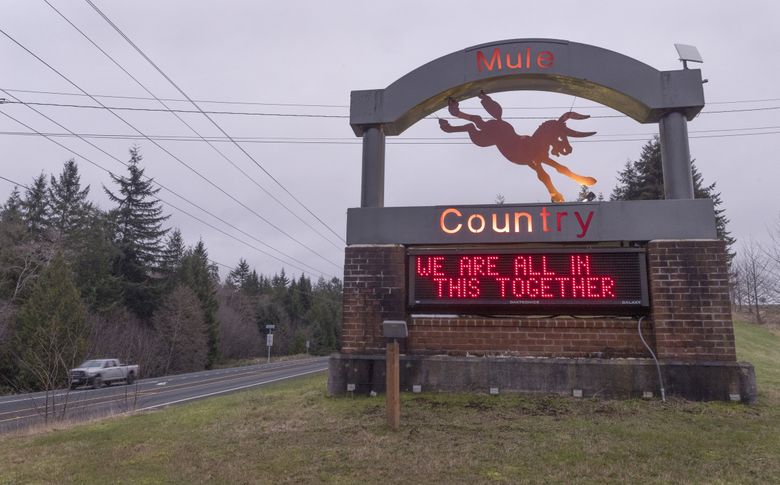CATHLAMET — It’s an unremarkable day at the Wahkiakum School District when a bathroom floods, rainwater drains from the ceilings and classrooms are cold enough that teachers pass out blankets.
From his office at the front of the high school, Superintendent Brent Freeman can hear kids from rival sports teams disparaging the building as they walk inside. His brain is an intimate catalog of the district’s various infrastructural failures and how to fix them. That is, when they finally get the money.
This 433-student district on the Columbia River hasn’t been able to pass a school bond — the main way that school districts raise money for building and repairing schools — for 22 years. And the state’s largest lifeline for school construction funding won’t spare a dime unless they can pass one.
Frustrated by the perennial failure of school bonds, this tiny district is suing the state in a move that, if successful, could change the way school building construction is funded across Washington.
When a bond fails, there are slim options for school districts in the state. While large and wealthy districts like Seattle can run several school construction measures simultaneously, an increasing number of property-poor districts cannot get their measures over the hump. Districts like Wahkiakum are left scrambling for whatever patchwork of funding they can find to prolong the life of deteriorating buildings.
“With so many of our systems, we are one rung away from total failure,” said Freeman.
In 2022, only 21% of the bond issues that went before voters in districts across the state won approval; bonds require a 60% yes vote. Had all those issues passed, they would have raised $778 million collectively.
Wahkiakum last attempted a $28.7 million bond measure in 2020, garnering only a 30% approval. The next year, Freeman asked the Legislature for money. The majority of the request was rejected. Out of options, as district officials tell it, they sought a solution in the courts.
To comply with a state Supreme Court order, Washington has invested billions to address a central driver of educational inequity: reliance on local taxpayers to fund academics. That case, McCleary v. Washington, rested on the state’s constitutional promise to make education funding its paramount duty. Wahkiakum, represented by the attorney who won the McCleary case, sees no reason why this promise shouldn’t apply to school buildings.
The state’s highest court will decide the fate of the district’s lawsuit sometime this year. If the district wins, the state would become responsible for funding building construction and repairs that are required to safely provide kids an education, the second massive and court-ordered infusion of cash into the state’s K-12 system in less than a decade.
The inequities in Washington state’s school construction model are openly acknowledged by state officials. At a time when the cost of construction is soaring, poor and small districts must tax more per household compared to wealthy urban districts, a hard sell for already weary voters.
There are no traffic lights in all of Wahkiakum County, only a single (and reportedly controversial) school speed zone along the lone and verdurous Highway 4, the road that connects some 4,000 people living along this rural stretch of the Columbia River.
That is appealing to the few who live here — a quiet, autonomous life on the water. But living in such a remote area has its drawbacks. There is one job for every six people in the county, and nearly two-thirds of students qualify for free and reduced price lunch. Kids have been found living alone in sheds and dwellings with no running water or electricity. The formerly booming logging and fishing county is now sought out by retirees.
“It’s a place where the beauty hides the poverty,” said Freeman.
The district’s three schools are located on the same campus in the county seat of Cathlamet, whose downtown overlooks the river. Nearly 100 acres of unused land owned by the district sits behind the baseball diamond. Bears, deer and bald eagles circle the area.
The school district is the center of the community and its largest employer. The grounds are a venue for weddings and funerals. Students bring hunted game to the campus to smoke and butcher. Occasionally, private money comes in for pet projects, such as a sports building or welding garage.
Freeman, a retired U.S. naval officer, knew the district had money woes when he took the job five years ago. When courting voters hasn’t worked, the district has tapped into a network of federal and state grants, and private donations. But these have amounted to Band-Aids.
“It’s just a constant drip,” said Paul Lawrence, the district’s only full-time maintenance worker, of the district’s maintenance problems. “There are calls from 7:30 a.m. to 2 a.m.”
The high school building is in the worst condition. Built in 1962, it has never had a major remodel. The lunchroom is so small that teens eat in the hallways or at the Shell gas station. Students head outside for chemistry experiments because the science room’s sinks and ventilation are broken.
Almost all the flooring in the building has an asbestos base, which is sealed in by wax. The fire alarm system also is from 1962. When the system is triggered, the control panel gets so hot that it requires a leather welding glove to touch.
Crumbling school infrastructure has negative consequences on student academic achievement, and the reverse is true when a school gets major building improvements. Princeton and University of Chicago researchers found strong gains in reading among students in Connecticut who moved into a rebuilt or renovated school.
In Wahkiakum, the students handle their surroundings with good humor.
“It’s so refreshing,” joked Brookylnn Luthi, a senior, about the water leaks from the ceiling. “Like a shower.”
But several said they could recognize that there’s something missing from their experience.
“People ask me if they’re likely to get into college compared to someone from Seattle and I tell them there’s a chance but I really don’t know,” said Malia Ana Silva, one of Wahkiakum High School’s student body presidents.
When a building gets to a certain age, repairs can be more complicated than a remodel. Fixing the sinks in the science classroom, for example, would require uprooting the asbestos floor, creating a health hazard. And there’s not a simple way to fix ventilation in one classroom without addressing the entire school.
On a recent day this winter, teacher Jeff Rooklidge’s chemistry class went outside in chilly weather and sat on bleachers to create copper sulfide.
“I’ve tried to do the best with what I have. But what haunts me is the kid who walks into (college) and doesn’t know the parts of a lab,” he said. “I try to do as much as I can out in the forest or stream with them.”
Over winter break, a pump in the elementary school boiler room failed, bursting the pipes in two classrooms. Water spilled through vents. Just after Christmas, Freeman, Lawrence and a custodian waded through the water for six hours to troubleshoot the leaks.
The part needed for the heating system is obsolete, so the district would need to place an expensive custom order to fix it.
The last bond issue, passed in 2001, initially failed six times. With each attempt, the district reduced the asking amount and therefore the scale of repairs.
“It’s like being nibbled to death by ducks,” said Bobbie Stefan, one of the district’s school board members.
The voter base, mostly Republican, has steadily approved operations levies, which pay for salaries and academic parts of the budget. But it has become harder to persuade voters to pass bonds. Part of it is poverty, another part anti-tax sentiment.
But even if the district were to be successful with bonds at the level of funding it needs, the issue of equity remains, said Freeman.
Wahkiakum’s 2020 bond would have raised $28.7 million to renovate and expand Wahkiakum High and the K-8 building. The cost would have been $3.37 per $1,000 of assessed property value, or $1,348 annually for a $400,000 home. In 2022, the Renton School District proposed and passed a tax rate 10 cents lower and raised $676 million.
McCleary v. Washington was a bit like the Normandy invasion, said Tom Ahearne, the lead plaintiff’s attorney in that case and in Wahkiakum’s.
The plaintiffs, two families, had the backing of dozens of school districts, teachers unions and a large roster of advocacy organizations. It was an expensive affair that dragged on for years, the ruling only deemed fully satisfied in 2018.
This Wahkiakum case is more like David vs. Goliath, he said. Just one district is necessary to tell the story.
“The state, they’ll say we’ve got all these robust programs and everything. They don’t do diddly,” said Ahearne.
The Washington State Attorney General’s Office declined an interview about the case.
In court documents, the state argues that construction costs are not the responsibility of the state, and that the function of school bonds is explicitly mentioned in the state constitution.
“If the State was not required to fully fund the additional classrooms needed for its program of basic education in … McCleary,” the state shouldn’t be compelled to fund Wahkiakum’s construction costs, the state’s reply says.
The School Construction Assistance Program (SCAP) is the largest source of state funding for construction costs. The Legislature allocates funding based on the projected need from year to year, around half a billion for the 2021-2023 biennium. But there are also major barriers to the program — one of them being that districts have to run a successful bond first. When bond failures are high, like they have been recently, as much as half of the program’s funding isn’t ever claimed by districts.
The construction program doesn’t cover everything; it will only match a certain percentage of funds the district collects in a bond. Within that match is a series of rules for what the state will fund and a reimbursement rate that state education department officials acknowledge is antiquated.
The state’s current reimbursement rate is $246 per square foot. A recent check by OSPI showed the actual costs for construction nowadays are around $500 per square foot, said Randy Newman, who oversees school facilities at OSPI.
“Some districts don’t have the property values to make all the needed renovations to their facilities,” said Newman. “It costs so much to modernize a school these days.”
Bonds are difficult to pass, said Newman, because of the 60% needed for approval. Wealthier districts in the Puget Sound region sometimes opt for capital construction levies because they only require a simple majority. But for most districts, bonds are the favored approach because payments can be stretched out decades, lessening the overall load on taxpayers.
Many lawmakers agree that the state could contribute more money. But their efforts so far have been limited to grant programs. Even those who’ve been advocates for Wahkiakum and rural school district funding, like State Rep. Joel McEntire, R-Cathlamet, still want to see sizable investment from local taxes.
McEntire, a Wahkiakum alumnus, introduced a bill this year that would create a grant specifically for small districts like Wahkiakum that can’t pass a bond. Under the original proposal, the state would’ve fronted 70% of construction costs, and the district would cover 30%. The latest version of the bill, which passed the House last week, would cover up to half of the costs.
“If a community can’t pull together 30%, they need to downsize the school. I don’t believe in giveaways. If even then a community isn’t able to pull together, I don’t know what kind of community that is,” McEntire said last month, referencing the earlier version of the bill.
But Wahkiakum is hoping for an outcome that would work more like school operations funding, where schools would get money based on the features of their district, like enrollment. Local contributions would fund nonessential projects.
“It would have massive negative impacts — our state constitution limits the amount of bonds,” said Mark Mullet, a state senator from Bellevue who leads the senate’s capital construction budget committee. “K-12 always receives the lion’s share of the budget — and they deserve that bucket, but they can’t take all of it.”
That’s the biggest obstacle for Wahkiakum in the courts. The justices could see this case as moot since the McCleary order released billions in school funding. Getting that accomplished took years, and took holding the Legislature in contempt of court.
On March 14, the two sides will come together at the Supreme Court for the first and only hearing of the case. Except it won’t be at the building where the Court typically meets. That one is under renovation.


